Explain, using sketches, the viscous flow past a long circular cylinder, with the flow direction being perpendicular to the longitudinal axis of the cylinder. Include in the explanation: boundary layer, wake, Reynolds number, drag and separation.

The flow in which the velocity of flow is constant or varies uniformly at any point is known as viscous flow. In the viscous flow, the viscosity is not zero.
The sketch of viscous flow past a long circular cylinder, with the flow direction being perpendicular to the longitudinal axis of the cylinder is shown below with boundary layer, wake, Reynolds number, drag, and separation.

A thin layer of viscous fluid close to the solid surface in which the velocity of the fluid varies from zero at the contact surface to of the initial velocity is called the boundary layer.
The pressure gradient will be favorable for flow if the pressure decreases in the direction of the flow. In this case, the pressure force will help in the movement of the fluid and no flow retardation will occur.
The adverse pressure gradient condition will occur when the pressure is increasing in the direction of the flow. As the flow is viscous so there is a strong viscous force that will act, and the fluid particles now have to move against the increasing pressure force. In this case, the flow of fluid is stopped or reversed that causes the neighboring particles to move away from the surface. This phenomenon is called the boundary layer separation.
Step by step
Solved in 2 steps with 1 images









